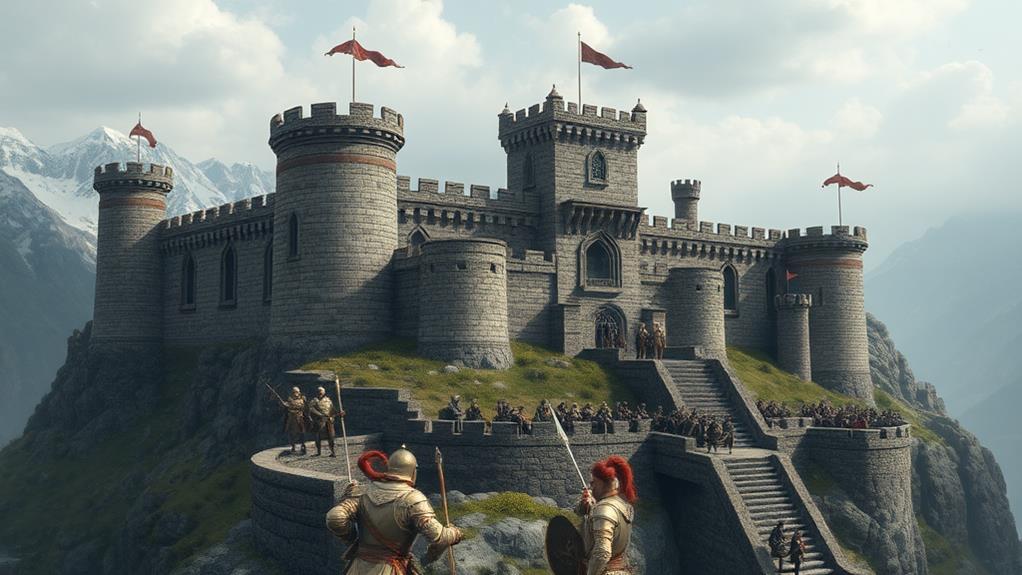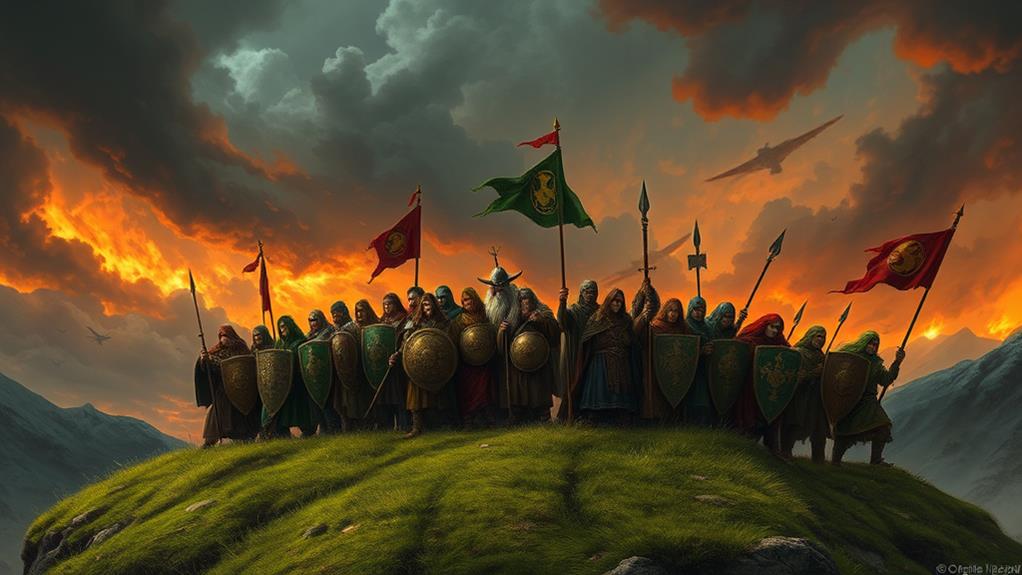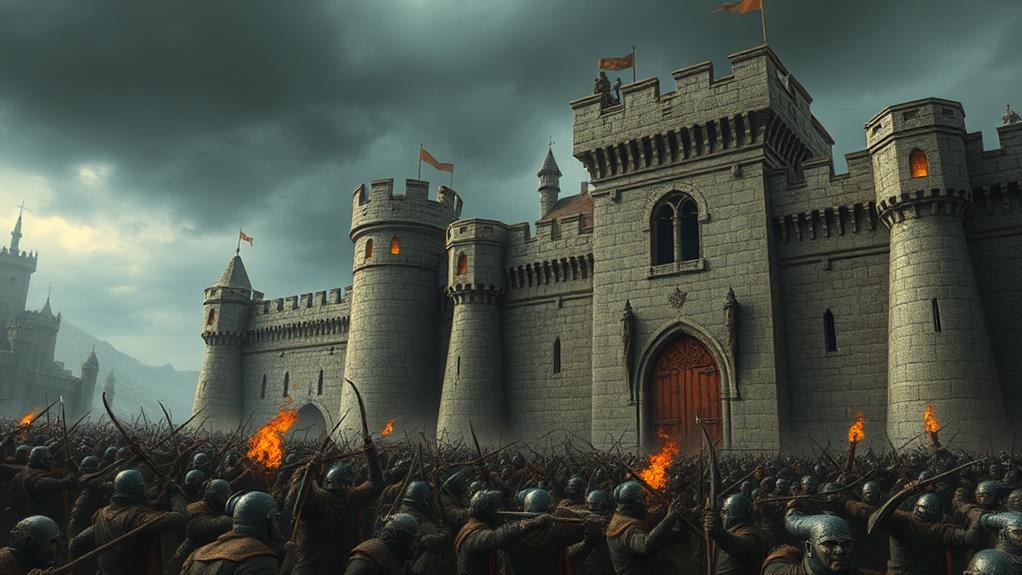
In Middle Earth, you'll encounter top defensive warfare tactics like using fortified strongholds such as Helm's Deep and Minas Tirith with their high walls and narrow entrances. Strategic retreats are essential to regroup and strike back effectively. Forming defensive alliances, like the Last Alliance of Elves and Men, bolsters your defenses. Natural barriers like mountains and forests, combined with the tactical use of magic, create formidable obstacles. Employ guerrilla tactics in dense terrain, and guarantee robust siege defenses with layered barricades and well-placed archers. Ready to master these strategies and protect Middle Earth against any threat? Leverage the mobility of cavalry units to disrupt enemy supply lines, while deploying scouts to gather crucial intelligence on enemy movements. Master Middle Earth conquest tactics by understanding the importance of timing and terrain, ensuring your forces exploit every advantage in battle. Finally, never underestimate the power of morale—rally your troops with inspiring leadership to secure both loyalty and victory in the most dire of situations.
Fortified Strongholds

In times of war, fortified strongholds served as the backbone of Middle Earth's defense strategy. You'd find these imposing structures strategically placed to protect key regions, acting as both deterrents and safe havens. Think of Helm's Deep, a near-impregnable fortress nestled in the White Mountains, where the people of Rohan sought refuge. Its high walls and narrow entrances made it a formidable barrier against enemy forces.
Similarly, Minas Tirith, the capital of Gondor, stood as a beacon of hope with its towering walls and multiple levels. You couldn't just stroll into a place like that; every advancing step was a battle. The city's design guaranteed that defenders had the upper hand, raining arrows and rocks upon invaders from above.
Strongholds weren't just about walls and gates, though. They were hubs of logistical support. You'd see armories stocked with weapons, food supplies to withstand sieges, and trained soldiers ready for battle. These strongholds embodied resilience and strategic ingenuity, making them indispensable in Middle Earth's wartime efforts. So, when danger loomed large, you knew where to turn, thanks to these mighty fortresses that stood guard over the land.
Strategic Retreats
When the odds were overwhelmingly against them, Middle Earth's defenders often executed strategic retreats to preserve their forces and regroup. This tactic wasn't about surrender; it was about living to fight another day. By carefully planning their exits, they were able to avoid unnecessary losses and maintain the strength needed for future battles.
To execute a strategic retreat effectively, you need to follow a few essential steps:
- Assess the Situation: Evaluate the enemy's strength, your own position, and potential escape routes. Knowing when to retreat is just as vital as knowing how.
- Coordinate the Withdrawal: Confirm all units know the retreat plan. Miscommunication can lead to chaos and increased casualties. Use signals or messengers to maintain order.
- Cover the Retreat: Designate rear guard units to hold off the enemy while the main force withdraws. These brave soldiers buy precious time for the rest of the army to escape.
Defensive Alliances

Defensive alliances played an essential role in Middle Earth's warfare strategy, as no single kingdom could withstand the might of their enemies alone. You'd find that forming pacts with neighboring territories bolstered defenses and created a united front against common threats. The most notable example is the Last Alliance of Elves and Men, which combined forces to confront Sauron's growing power. This coalition showcased the strength in numbers and the strategic advantage of pooling resources and military expertise.
When you align with other kingdoms, you're not just gaining allies; you're sharing intelligence, tactics, and manpower. These alliances often meant the difference between survival and annihilation. For instance, the Ents' alliance with the people of Rohan at the Battle of Isengard was critical. Their unique strengths complemented each other, turning the tide against Saruman's forces.
It's vital to remember that alliances aren't just about military might. Diplomatic relationships foster trust and mutual support, ensuring that aid is available in times of need. By working together, you create a network of support that can respond swiftly to emerging threats, leveraging combined strengths to defend against even the most formidable adversaries.
Natural Barriers
Though often overlooked, natural barriers serve as some of the most effective defensive tools in Middle Earth. These features can turn the tide of battle without the need for additional fortifications or manpower. When you understand how to use them to your advantage, you'll find that nature itself can be your greatest ally.
Consider these three key types of natural barriers:
- Mountains: The Misty Mountains, for example, create formidable obstacles, making invasions arduous and slow. Enemy troops are forced to navigate treacherous passes, giving you time to prepare and counterattack.
- Forests: Dense woods like Fangorn Forest offer concealment and ambush opportunities. Hidden paths and thick underbrush can disorient invaders and provide strategic advantages to those who know the terrain well.
- Waterways: Rivers and lakes, such as the Anduin River, act as natural moats. They can be used to block or divert enemy forces, making it difficult for them to advance without the aid of bridges or boats.
Use of Magic

Nature's barriers aren't the only tools at your disposal; magic also plays a significant role in defensive warfare in Middle Earth. Wizards, elves, and other magical beings can conjure powerful spells to protect their domains. Think about Gandalf's barrier against the Balrog in Moria or the elves' enchantments that concealed Rivendell and Lothlórien. These magical defenses can turn the tide of battle, offering protection that physical fortifications alone can't provide.
You can use enchantments to create illusions, making your stronghold appear impenetrable or even invisible. Such spells confuse and disorient enemies, buying you precious time to regroup or launch a counterattack. Another tactic is using wards and magical barriers to prevent entry. These can be as subtle as a hidden charm or as overt as a glowing force field, stopping foes in their tracks.
Then there's the use of elemental magic. Summon a storm to impede an advancing army or create walls of fire to block passage. Even the most fearsome adversaries will think twice before crossing such barriers. Don't underestimate the power of magic in your defensive strategy; it can mean the difference between victory and defeat.
Guerrilla Tactics
When facing a numerically superior enemy, guerrilla tactics can become your greatest ally in Middle Earth. By leveraging the terrain and engaging in hit-and-run attacks, you can outmaneuver even the most formidable foes. These tactics rely on surprise, mobility, and intimate knowledge of the landscape.
To effectively employ guerrilla tactics, consider the following strategies:
- Ambushes: Set traps and ambushes in dense forests or narrow mountain passes. The element of surprise can cause confusion and chaos among enemy ranks, allowing you to inflict significant damage before quickly retreating.
- Hit-and-Run Attacks: Use swift, unexpected strikes to keep the enemy off-balance. Attack their supply lines or isolated units, then disappear before they can organize a counterattack. This will gradually wear down their resources and morale.
- Utilize the Terrain: Take advantage of Middle Earth's diverse landscapes. Use the cover of forests, caves, and rocky outcrops to conceal your movements and launch attacks from unexpected angles. Knowledge of the local terrain gives you a strategic edge over less familiar invaders.
Siege Defenses

Defending a fortress during a siege in Middle Earth requires a combination of strategic foresight and resourcefulness. You'll need to understand your fortress's strengths and weaknesses. Reinforce the walls with sturdy materials like stone and iron; weak points must be shored up to withstand battering rams and catapults. Use natural obstacles like rivers or cliffs to your advantage, making it harder for enemies to approach.
Equip your archers with plenty of arrows and position them in high towers for maximum range and effectiveness. Boiling oil and tar can be poured over the walls to deter climbers. Keep a stockpile of food and water to outlast the enemy, ensuring your troops' morale and physical strength stay high.
Establish multiple layers of defense. If the outer wall is breached, retreat to inner fortifications that are equally well-prepared. Digging trenches and setting up spike traps can slow down advancing forces. Communication within your ranks must be swift and efficient, using signals or runners to relay important information.
Intelligence Gathering
Effective intelligence gathering is essential in Middle Earth's defensive warfare. You need to know your enemy's movements, strengths, and weaknesses to mount an effective defense. Here's how you can master this vital tactic:
- Scout Networks: Deploy scouts to monitor enemy activity. These skilled individuals can provide real-time updates on troop movements, supply lines, and potential threats. Utilizing elven scouts, who blend seamlessly into their surroundings, can be particularly effective.
- Communication Systems: Establish reliable communication channels. Whether it's beacons, messenger birds, or enchanted mirrors, ensuring swift and secure transmission of information is paramount. This rapid exchange helps you adapt and respond to changing battlefield conditions.
- Interrogation and Espionage: Capture enemy soldiers and gather intelligence through interrogation. Additionally, infiltrate enemy ranks with spies to acquire insider information. It's risky, but the rewards regarding strategic advantage are immense.
At a Glance
In Middle-earth, defending your home isn't just about walls and swords. It's about the heart behind the stone, the alliances forged in trust, and the magic that binds you. Think of each tactic like a thread in a grand tapestry, each one essential to the picture of survival and hope. So, when you stand on that battlement, remember: you're not just defending land; you're safeguarding stories, dreams, and the very spirit of Middle-earth.






